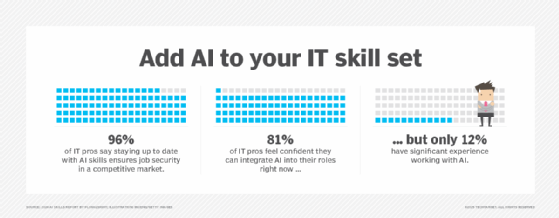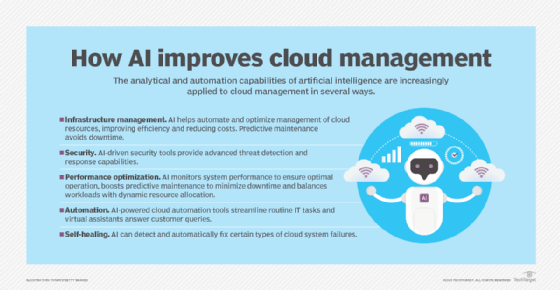
Getty Images/iStockphoto
How to use AI to bridge the cloud skills gap
Once admins have acknowledged the cloud skills gap within their team, it's time to act. Can AI offer teams the resources they need to help reach peak efficiency?
Many aspects of cloud management remain unfamiliar to admins. Whether adapting to on-premises deployments from cloud-based infrastructures or maintaining skilled staff to design and implement cloud resources, admins must address the cloud skills gap to ensure their teams are effective.
The skills gap is a serious concern, encompassing every aspect of cloud management. The continued advancements in AI also affect the cloud industry, and leaders must confront the concerns they bring. However, AI also provides new opportunities for supporting IT staff as they progress through skills training and cloud certifications.
Let's examine strategies organizations can use to bridge the cloud skills gap with AI. Learn how this new tool can benefit various members of your IT staff, including the following:
- Accounting personnel.
- Cloud administrators.
- Cloud architects.
- Decision-makers and stakeholders.
- Developers.
- Help desk support personnel.
- Tier 2 technical support.
AI-assisted technical support
This aspect of AI assistance within cloud administration covers proactive issue avoidance, issue diagnosis, incident response and prevention. Examples abound of how AI-assisted support can aid overworked and undertrained cloud administrators.
Consider the following examples:
- AI chatbots and virtual assistants. These provide natural language environments for information gathering and research. Chatbots and virtual assistants are far quicker than searching through thousands of web search results.
- Real-time feedback. This offers administrators an immediate response to security incidents, configuration changes and performance metrics. The faster an issue is resolved, the better.
- Documentation generated by AI. Generative AI (GenAI) offers natural language support for custom programs, coding projects and web apps.
- Automated incident management. Automation lets administrators focus on other tasks during routine incidents, like drive or VM instance failures.
- Cost optimization. Cloud administrators can offload the time-consuming task of optimizing their costs. Despite roles like FinOps assisting, researching the intricacies of cloud costs can be a significant effort.
- Resource management. It can be challenging for newer cloud administrators to understand the best options for resource allocation while balancing costs. Leaders should consider automating some basic resource management tasks with AI.
- Security analysis. Security is a critical part of every cloud administrator's job. However, admins must know how to manage an extensive cloud deployment. AI helps by analyzing current configurations and suggesting improvements.

AI-assisted data analytics
AI's ability to consume, analyze and summarize massive amounts of information is unparalleled. Turning this power toward cloud administration tasks helps administrators with data analysis, enabling their staff to act on actionable data. Stakeholders can improve their decision-making and streamline cloud deployment. Detailed and complete reporting enables long-term planning and trend tracking.
Features include the following:
- Real-time resource monitoring. This includes anomaly detection and predictive analysis to find service failures and suggest remediation options.
- Resource optimization. This ensures cost savings, service efficiency and scaling.
- Security analysis. This avoids misconfigurations while mitigating risks and providing disaster recovery options.
- Broad analysis capabilities. These include hybrid and multi-cloud deployments, IoT devices, social media and marketing information.
AI-assisted cloud deployments and migrations
Some organizations are on their way toward full cloud deployments, whether with new apps and services or existing components migrated from an on-premises network. The planning and effort involved in this process can be overwhelming, especially for an IT staff that doesn't have the necessary skills.
The following are some of the ways AI can assist with cloud deployments and migrations:
- Cloud readiness assessments. AI can analyze various aspects of an organization's cloud readiness, including applications, coding, infrastructure management, services and internet connectivity.
- Deployment and migration planning. This directly affects the success of cloud infrastructure and the services it supports. The design and planning stages can be some of the most difficult. AI can draw upon a much deeper body of knowledge than your organization's administrators will likely have.
- Tool and service suggestions. AI can suggest specific migration tools and strategies to streamline and simplify the process. This can save time and help prevent mistakes made by less experienced cloud administrators or consultants.
- Postdeployment or postmigration resource management. The early period of a new cloud deployment is highly dynamic. Use AI to analyze usage patterns, dynamically allocate resources and automate tasks.

AI-assisted coding
AI-assisted coding can benefit teams that are not yet familiar with cloud app development. Some organizations also integrate it with the review and testing process to help catch errors and facilitate optimization.
The following are some ways that AI can help with coding:
- Premigration code modernization. AI can identify dependencies, older versions and other common refactoring opportunities in code modernization.
- Code generation. The code generation is based on natural language input. Code may be snippets, complete blocks or entire projects.
- Code review. The review checks for bugs, security vulnerabilities, optimization and maintainability issues.
AI-based skills assessment and training
AI is no substitute for a knowledgeable and experienced human staff, but it can help develop them. Why not draw on AI to create the skilled cloud administrators needed to maintain a cost-effective, efficient and secure cloud environment?
Use AI to empower cloud administrators by integrating the following strategies into employee upskilling plans:
- Automated skills assessments. Establish learning plans that include upskilling and certifications.
- Personalized learning paths. Tailor these to any demonstrated employee skills, reducing wasted time covering topics participants are already comfortable with.
- Adaptive learning systems. Only cover specific technologies and approaches based on company requirements and existing employee skills.
- Soft skills assessments and training. Interpersonal skills are just as important as technical skills. AI can provide the resources to help IT teams improve their soft skills and work effectively with other departments and stakeholders.
- Skills gap analysis. Admins can understand the gaps in knowledge within their teams and the job roles their organization relies on.
Damon Garn owns Cogspinner Coaction and provides freelance IT writing and editing services. He has written multiple CompTIA study guides, including the Linux+, Cloud Essentials+ and Server+ guides, and contributes extensively to Informa TechTarget, The New Stack and CompTIA Blogs.








